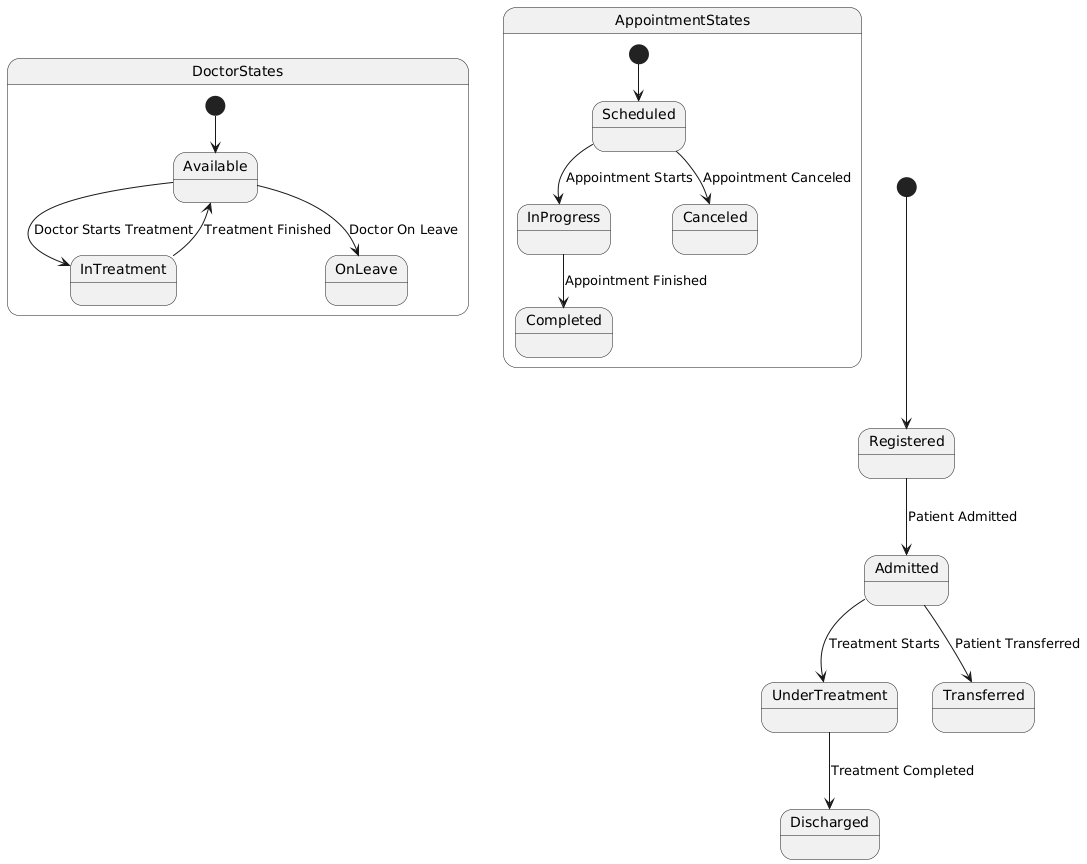OOAD-LAB-VI-SEM
Exercise 09
Drawing State Chart Diagram for Hospital Management System
Aim
To draw the State Chart Diagram for a Hospital Management System.
Theory
A State Chart Diagram in UML is used to describe the states of an object and the events that trigger transitions between those states. In a Hospital Management System, the diagram focuses on the dynamic behavior of key entities such as Patient, Doctor, Appointment, and Treatment.
For example, a patient in the hospital may go through states such as “Admitted”, “Under Treatment”, “Discharged”, and “Transferred”. A doctor may go through states like “Available”, “In Treatment”, and “On Leave”.
Procedure/Program
- Identify States:
- Patient States:
- Registered: The patient has been registered in the hospital system.
- Admitted: The patient has been admitted to the hospital for treatment.
- Under Treatment: The patient is receiving treatment or undergoing surgery.
- Discharged: The patient has completed their treatment and is being discharged from the hospital.
- Transferred: The patient is being transferred to another department or hospital.
- Doctor States:
- Available: The doctor is available for consultation or treatment.
- In Treatment: The doctor is engaged in providing treatment to a patient.
- On Leave: The doctor is unavailable due to personal leave or vacation.
- Appointment States:
- Scheduled: An appointment with a doctor has been scheduled for a patient.
- In Progress: The appointment is currently taking place.
- Completed: The appointment has concluded, and the patient’s consultation or treatment is finished.
- Canceled: The scheduled appointment was canceled by the patient or doctor.
- Patient States:
- Define Transitions:
- Patient Transitions:
- From Registered to Admitted: Triggered when a patient’s condition requires hospitalization.
- From Admitted to Under Treatment: Triggered when treatment begins.
- From Under Treatment to Discharged: Triggered when the treatment is completed, and the patient is ready for discharge.
- From Admitted to Transferred: Triggered if the patient needs to be moved to a different department or hospital.
- Doctor Transitions:
- From Available to In Treatment: Triggered when the doctor starts treating a patient.
- From In Treatment to Available: Triggered when the treatment is over, and the doctor is free.
- From Available to On Leave: Triggered when the doctor goes on vacation or is unavailable.
- Appointment Transitions:
- From Scheduled to In Progress: Triggered when the appointment time arrives, and the consultation begins.
- From In Progress to Completed: Triggered when the appointment is completed.
- From Scheduled to Canceled: Triggered when the appointment is canceled by the patient or doctor.
- Patient Transitions:
- Draw the State Chart Diagram:
- Represent each state as a rounded rectangle.
- Use arrows to represent transitions between states.
- Label each transition with the event that causes the state change.
- Indicate any conditions that might affect transitions, such as doctor availability or appointment cancellations.
Output/Explanation

- State Chart Diagram:
- The output will be a state chart diagram showing the different states for
Patient,Doctor, andAppointment, as well as the transitions between them.
- The output will be a state chart diagram showing the different states for
Example of states and transitions for a Patient:
- Registered → Admitted → Under Treatment → Discharged.
- Admitted → Transferred → Admitted (in another department or hospital).
- Under Treatment → Discharged.
Example of states and transitions for a Doctor:
- Available → In Treatment → Available.
- Available → On Leave → Available.
Example of states and transitions for an Appointment:
- Scheduled → In Progress → Completed.
- Scheduled → Canceled.
Explanation:
- The State Chart Diagram models the dynamic behavior of patients, doctors, and appointments in the Hospital Management System.
- It highlights how a patient progresses from being registered to receiving treatment and being discharged, and how the doctor moves between being available, treating patients, and taking leave.
- The appointment states show the lifecycle of an appointment, from scheduling to completion or cancellation.
This diagram is valuable for understanding the flow of activities in a hospital, helping to improve operational efficiency and patient care.